It’s surprising that as of Windows 8, Microsoft hasn’t added a native print to PDF function. In searching for a free solution, I looked at CutePDF Writer, doPDF Free PDF Converter, and PrimoPDF. I thought this would be a straightforward comparison, there ended up being no clear winner.
I printed (using program defaults) one page from the Wikipedia PDF page and compared the output. On Windows 7 Home Premium, I used Google Chrome‘s (version 25.0.1364.172 m), Firefox (version 8.0.1), and Internet Explorer (version 9.0.8112.16421) 64-bit Edition. I also compared the output of these PDF printers to Chrome’s and MacOS’s built in PDF printers.
CutePDF
Link: http://www.cutepdf.com/products/cutepdf/writer.asp
Version: 3.0
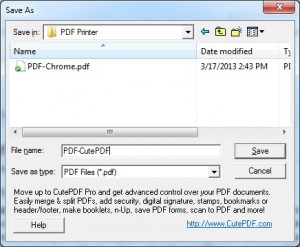
Pros
- High Quality Images: I could not discern a degradation of the image compressed by CutePDF.
- Clean Interface: CutePDF does nor present the user with options. When you click “Print”, it asks you where you’d like to save the file.
Cons
- Slow initialization: 2 seconds or more from clicking “Print” to when the save dialog appears
- The save dialog doesn’t grab focus. After clicking “Print” and waiting a few seconds, I had to click on the browser window to get the save dialog to appear.
-
- Large Files: the PDFs generated by CutePDF were between 79KB and 84KB
- Old Save Dialg: CutePDF uses Windows save dialog that does not display the Navigation Pane.
- Installer tried to install two foistware that I had to opt-out of. Make sure you opt out of these, but install ps2pdf which is required.
doPDF Free PDF Converter
Link: http://www.dopdf.com/
Version: 7.3.388
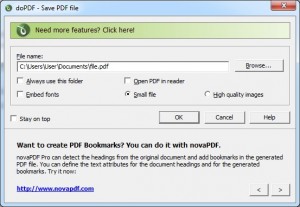
Pros
- The installation was straightfoward with no surprises.
- Small files: the PDFs generated by doPDF were between 17KB and 27KB
Cons
- Errors: Clicking cancel when printing from IE resulted in IE thinking there was an error printing. Also, saving to my E: drive, doPDF gave me permission errors, and I haven’t been able to figure out why.
- Low quality images: There is noticeable blurring of the PDF icon even without zooming in.
PrimoPDF
Link: http://www.primopdf.com/
Version: 5.1.0.2
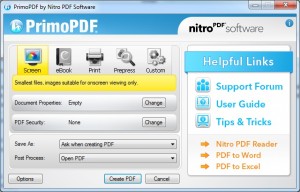
Pros
- The installation was straightfoward with no surprises.
- Lots of options, but tested with the default of saving files for viewing on a Screen.
Cons
- Low quality images: There is noticeable blurring of the PDF icon even without zooming in.
- Large files: the files generated by PrimoPDF were between 69KB and 82KB.
PDFCreator
Link: http://www.pdfforge.org/download
Version 1.6.2
Be careful while downloading, because the download page has ads that include “Download” links along with links to download other PDFForge programs.
Also while installing, make sure you uncheck the extra software. I don’t think you need to install “PDF Architect” or “COM samples”.
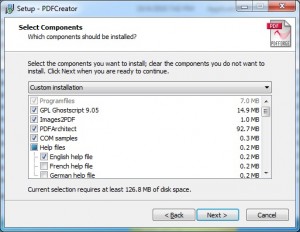
After installing (assuming you live in the US and want to print to letter sized paper), perform the following steps (in Windows 7) to change the default paper size:
- Open the Start menu
- Click “Devices and Pinters”
- Right click on “PDFCreator” and select “Printing preferences”
- Click the “Advanced…” button
- Use the “Paper Size:” drop down menu to select a new default paper size
- Click “OK”, “OK”, and close
Thanks thundt for the tip on PDFCreator’s default paper size.
Settings Dialog:
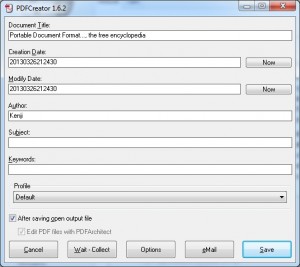
Pros
- Quick, accurate PDF creation.
- Straightforward, no settings.
- Quality: The icon on the page shows minor blurring when zooming in but does not show visible artifacts.
- Uses the standard Windows save dialog
- Allows the user to set a few properties in the PDF without complicating the creation process.
Cons
- Attempts to install extra unnecessary software.
- Large files, the sample was comparable to MacOS and CutePDF.
Reference Implementations
Chrome’s built in PDF function saved a sharp image, but generated a 110KB file.
MacOS PDF printer (used from Safari) saved a sharp image and generated a 82KB file.
Conclusion
For a simple straightforward print to PDF solution that you don’t have to worry about, I think PDFCreator is the best. It is quick, is very straightforward once configured, and produces quality PDFs. CutePDF is second, because of its quirks (the save dialog). Nowadays, space is cheap, so I’d rather make sure I’m saving what I’m seeing instead of saving some space.
The other options aren’t bad, and can probably produce comparable results, but I think printing to PDF should be a process that doesn’t require thought.
Files
 I accidentally stumbled upon this hint, because Marriott’s site as of January 2014 does not print nicely. The menus expand on their print css, so the real content shows up after a page long list.
I accidentally stumbled upon this hint, because Marriott’s site as of January 2014 does not print nicely. The menus expand on their print css, so the real content shows up after a page long list. 



